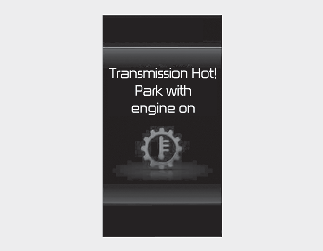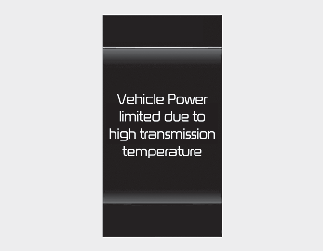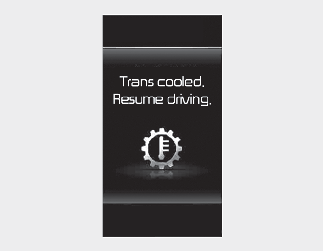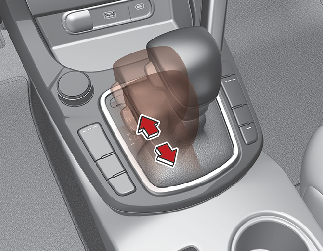Intelligent Variable Transmission (IVT) operation
For smooth operation, depress the brake pedal when shifting from N (Neutral) to a forward or reverse gear.

Intelligent Variable Transmission (IVT)
-
Always check the surrounding areas near your vehicle for people, especially children, before shifting a car into D (Drive) or R (Reverse).
-
Before leaving the driver's seat, always make sure the shift lever is in the P (Park) position; then set the parking brake fully and shut the engine off. Unexpected and sudden vehicle movement can occur if these precautions are not followed in the order identified.
-
Do not use the engine brake (shifting from a high gear to lower gear) rapidly on slippery roads.
The vehicle may slip causing an accident.

-
To avoid damage to your transmission, do not accelerate the engine in R (Reverse) or any forward gear position with the brakes on.
-
When stopped on an incline, do not hold the vehicle stationary with engine power. Use the service brake or the parking brake.
-
Do not shift from N (Neutral) or P (Park) into D (Drive) or R (Reverse) when the engine is above idle speed.
LCD display for warning message

-
When driving under severe conditions such as repeated sudden starts and sudden acceleration, the transmission may overheat, and a warning sound and a warning message appear on the instrument cluster due to the self-protection mode.
-
If this occurs, pull over to a safe location, stop the vehicle with the engine running, apply brakes and shift the gear to P (Park), and allow the transmission to cool.
-
If the warning message continues to appear, have the system checked by an authorized Kia dealer to prevent unexpected accidents.

-
If the transmission continues to drive overheating and reaches its maximum temperature, the above warning message appears. In this case, the vehicle limits transmission power by its self-protection mode.
-
When such a situation occurs, normal driving is restricted until the transmission goes down to normal temperature, so after moving the vehicle to a safe place, shift the gear to P (Park) with the engine running and wait several minutes until the warning on the screen disappears.
-
If the warning message continues to appear, have the system checked by an authorized Kia dealer to prevent unexpected accidents.

-
When the message "Trans cooled. Resume driving" appears you can continue to drive your vehicle.
Transmission ranges
The indicator in the instrument cluster displays the shift lever position when the ignition switch is in the ON position.
P (Park)
Always come to a complete stop before shifting into P (Park). This position locks the transmission and prevents the front wheels from rotating.

-
Shifting into P (Park) while the vehicle is in motion will cause the drive wheels to lock which will cause you to lose control of the vehicle.
-
Do not use the P (Park) position in place of the parking brake. Always make sure the shift lever is latched in the P (Park) position and set the parking brake fully.
-
Never leave a child unattended in a vehicle.

The transmission may be damaged if you shift into P (Park) while the vehicle is in motion.
R (Reverse)
Use this position to drive the vehicle backward.

Always come to a complete stop before shifting into or out of R (Reverse); you may damage the transmission if you shift into R while the vehicle is in motion, except as explained in More Details.
N (Neutral)
The wheels and transmission are not engaged. The vehicle will roll freely even on the slightest incline unless the parking brake or service brakes are applied.

Do not drive with the shift lever in N (Neutral).
The engine brake will not work and may lead to an accident.

-
Always park the vehicle in "P" (Park) for safety and engage the parking brake.
Parking in N (Neutral) gear
Follow below steps when parking and you want the vehicle to move when pushed.
-
After parking your vehicle, step on the brake pedal and move the shift lever to "P" with the ignition button in "ON" or while the engine is running.
-
If the parking brake is applied unlock the parking brake.
-
For EPB (Electronic Parking Brake) equipped vehicles, push the brake pedal with the ignition button in "ON" or while the engine is running to disengage the parking brake. If AUTO HOLD function is used while driving (If "AUTO HOLD" indicator is on in the cluster), press "AUTO HOLD" switch and "AUTO HOLD" function should be turn off.
-
-
While pressing the brake pedal, turn the ignition button "OFF".
-
For smart key equipped vehicles, the ignition switch can be moved to "OFF" only when the shift lever is in "P".
-
-
Change the gear shift lever to "N" (Neutral) while pressing the brake pedal and pushing "SHIFT LOCK RELEASE" button or inserting, pressing down a tool (e.g., flathead screw-driver) into the "SHIFT LOCK RELEASE" access hole at the same time. Then, the vehicle will move when external force is applied.

-
With the exception of parking in neutral gear, always park the vehicle in "P" (Park) for safety and engage the parking brake.
-
Before parking in "N" (Neutral) gear, first make sure the parking ground is level and flat. Do not park in "N" gear on any slopes or gradients.
If parked and left in "N", the vehicle may move and cause serious damage and injury.
-
After the ignition switch has been turned off, the electronic parking brake cannot be disengaged.
-
For EPB (Electronic Parking Brake) equipped vehicles with AUTO HOLD function used while driving, if the ignition button has been turned "OFF", the electronic parking brake will be engaged automatically. Therefore, AUTO HOLD function should be turned off before the ignition button is turned off.
D (Drive)
This is the normal forward driving position. The transmission will automatically shift, providing the best fuel economy and power.
For extra power when passing another vehicle or climbing grades, depress the accelerator fully, at which time the transmission will automatically downshift to the next lower gear.

Always come to a complete stop before shifting into D (Drive).
Sports mode

Whether the vehicle is stationary or in motion, sports mode can be selected by pushing the shift lever from the D (Drive) position into the manual gate. To return to D (Drive) range operation, push the shift lever back into the main gate.
SPORT mode manages the driving dynamics by automatically adjusting the steering effort, and the engine and transmission control logic for enhanced driver performance.
In sports mode, moving the shift lever backwards and forwards will allow you to select the desired range of gears for the current driving conditions.
-
Up (+): Push the lever forward once to shift up one gear.
-
Down (-): Pull the lever backwards once to shift down one gear.

-
In sports mode, the driver must execute upshifts in accordance with road conditions, taking care to keep the engine speed below the red zone.
-
In sports mode, only the 8 forward gears can be selected. To reverse or park the vehicle, move the shift lever to the R (Reverse) or P (Park) position as required.
-
In sports mode, downshifts are made automatically when the vehicle slows down. When the vehicle stops, 1st gear is automatically selected.
-
In sports mode, when the engine rpm approaches the red zone shift points are varied to upshift automatically.
-
To maintain the required levels of vehicle performance and safety, the system may not execute certain gearshifts when the shift lever is operated.
-
When SPORT mode is activated:
-
The engine rpm will tend to remain raised over a certain length of time even after releasing the accelerator.
-
Upshifts are delayed when accelerating.
-
-
In SPORT mode, the fuel efficiency may decrease.